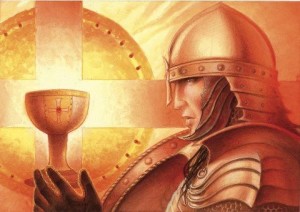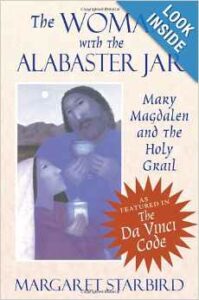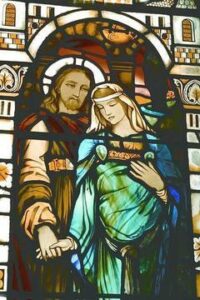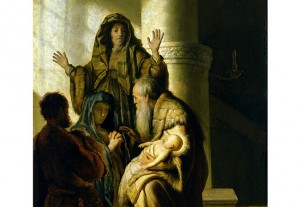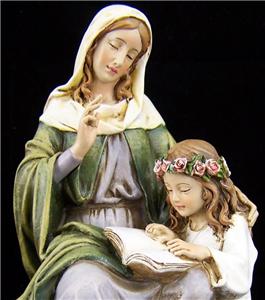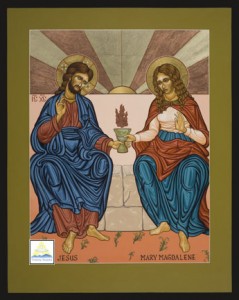
My friend (and teacher these 20 years now!), Margaret Starbird writes:
copyright 2014 by Margaret Starbird. All rights reserved.
06-02-14
A Timely Lesson
In 1983 Ann Requa, a dear friend since my college years at the University of Maryland, told me about Holy Blood, Holy Grail, that she thought I needed to read the book, and that I could probably find a copy in my local library. A few days later I looked the title up in the lubrary’s card catalogue, found it listed, and discovered it in the stacks. The front cover said Holy Blood, Holy Grail, as expected. But the back cover asserted that Jesus was probably married and that his wife and progeny survived the Crucifixion and fled into exile as refugees in Gaul. At the time in 1983 I was still “singing in the choir†and teaching catchism classes for the Roman Catholic Church, and I was definitely not inclined to accept any notion that I perceived as so clearly blasphemous.
For two years I did not read the book my friend had recommended, but, radically disillusioned after reading “In God’s Name†(an exposé of the Vatican Bank scandal and alleged assassination of Pope John Paul I by David Yallop), I returned to the library in 1985 and checked out Holy Blood, Holy Grail. I read the book from cover to cover, still reluctant to accept the fundamental premise of the marriage of Jesus to his “consort/companion†Mary Magdalene. I asked myself agonizing questions: How could we have lost the Bride of Jesus? How could the Church have hidden such a momentous secret for so many centuries? Surely the Church fathers would have told us if Jesus were married with children! I’ve recorded details of my quest for the truth of the Magdalene “story,†published in The Goddess in the Gospels in 1998. Numerous synchronicities and Scripture passages that confirmed the sacred partnership of Jesus and Mary Magdalene at the heart of the Christian story made their way into that book, so I won’t repeat them here.
But some important illuminating incidents didn’t make the “cut†for that book, including one I didn’t fully understand at the time, but which has grown on me over the years and has become a very important key understanding of the tragic consequences of the “Lost Bride.”
One Monday afternoon in 1986 while I was doing my usual chores, I sent out a special request—asking God to have the mailman deliver something to my mailbox that would confirm or deny the assertion of Holy Blood, Holy Grail that Mary Magdalene was the “Bride of Christ.†I had no idea what I would consider a proof or denial of the theory—but I asked for it anyhow.
When the mailman had passed, I ran to the box to see what he had left there. To my befuddlement, the only item in the box was a small package, about 7†by 10â€, from a company that  advertised ant farms. Opening the container, I remembered having ordered the item weeks before so I could teach my children about the almost legendary work-ethic and industry of ants. The advertisement for the “farm†stated that viewers could watch the community of ants through the plastic walls of the box — tunneling and moving food particles through the network of tunnels the worker ants would create. I was sad that I hadn’t received an answer to my prayer for the confirmation or denial of the “married Jesus†hypothesis, but I decided maybe my request had come too late — probably the mailman had already packed his bag and started on his rounds.
When the kids got home from school, they were excited the ant farm had arrived. They bent their heads together over the instructions and unpacked the package to set up the ant farm. There was a narrow box with clear plastic panels on each side, a package of sand and a small packet containing the live ants! Carefully we assembled the project, added the ants and watched as they began scurrying to and fro digging their first tunnel. Sure enough, over a period of hours, the ants built tunnels and started carrying food particles from place to place. The kids watched with fascination for a few minutes, then went on to other activities, returning at intervals to see how the ants were doing with their project. As advertised, the ants continued to scurry around behind their plastic walls tunneling and carrying food particles.
At breakfast the next morning, the kids inspected their ant colony performing its activities — and rushed in again after school. For several days the ant farm was a magnet for attention. Neighborhood children were invited in to watch the ants. Everyone was enjoying observing ants busily scurrying around inside their plastic box, tirelessly tunneling and carrying food particles hither and yon.
But by the end of the week activity gradually slowed and then finally ceased. The ants had apparently worn themselves out and one at a time had begun to die off. After another forty-eight hours, we sadly agreed that the experiment was over and that it was time to trash the ant farm. We had gotten the message that the ants were an industrious community, but somehow they had failed to thrive. We carried the plastic box out to the back yard and dumped the experimental ant farm onto the ground, hoping any survivors might find a new colony and home outdoors.
Much later I realized that I actually HAD received an answer affirming the “sacred marriage†in the mailbox that Monday afternoon. The meaning was clear. The ant community had failed to thrive because they had no “organizing principle†at the heart of their “farm.” The goal of any community, its “reason for being” is the continuity and nurturing of life. They had no Queen and therefore, no reason for their labor, no progeny to nurture, no “vocation.†All their activities were ultimately just “busy workâ€â€”and wasted.
I believe the earliest Christians established their community with the partnership of Jesus and Mary Magdalene at its heart — modeled on the “Song of Songs,†where the devoted relationship of the “Beloveds†was a mirror of God’s passionate love for his people. While Jesus represented Yahweh as “Bridegroom,†(an epithet confirmed in various Gospel passages), Mary Magdalene represented the people of Israel, the “Daughter of Sion,†as Sister-Bride and Beloved. Their union was celebrated at all levels of human experience, exemplified in the “Sacrament of the Bridal Chamber,†in early Christian communities.
In his letter to Corinthians 5:9, Paul states that Cephas and the brothers of Jesus and the other apostles all “travel around with their sister-wives.†Where did Paul get that phrase, if not from the original Christian community that modeled itself on the “Song of Songs,†derived from an ancient rite of “sacred marriage,’ where the Bridegroom frequently refers to his Beloved as “My sister, my spouse: “You have made my heart beat faster, my sister, my bride†(SoS 4:9); “a garden enclosed is my sister, my bride†(SoS 4: 12); and “I have come into my garden, my sister, my bride†(SoS 5:1).
English translations of Paul’s letter invariably call these sister-wives “Christian sisters†even though the phrase in the original Greek does not contain the word “Christian†at all.
Why did the Jerome and later translators of the Greek Gospels wish to obscure the knowledge that the closest associates and kin of Jesus traveled with their “sister-wives†as missionary couples, bearing the “Good News†to the farthest outposts of the Roman Empire? When he sent them forth “two by two,†Jesus was apparently sending couples, not pairs of males, according to Paul, the earliest witness to Christian practices.
It’s a good thing Noah didn’t misunderstand God’s instructions about bringing the animals into the ark “two by two†as the early church fathers apparently misunderstood the instruction of Jesus to preach the “Way of the heart†in a couples’ ministry!
* Â Â Â Â Â * Â Â Â Â * Â Â Â Â * Â Â Â Â *
